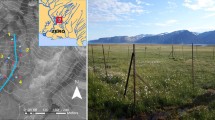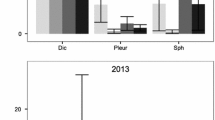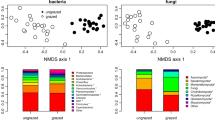Abstract
Herbivory and climate are key environmental drivers, shaping ecosystems at high latitudes. Here, we focus on how these two drivers act in concert, influencing the high arctic tundra. We aim to investigate mechanisms through which herbivory by geese influences vegetation and soil processes in tundra ecosystems under ambient and warmed conditions. To achieve this, two grazing treatments, clipping plus faecal additions and moss removal, were implemented in conjunction with passive warming. Our key finding was that, in many cases, the tundra ecosystem response was determined by treatment impacts on the moss layer. Moss removal reduced the remaining moss layer depth by 30% and increased peak grass biomass by 27%. These impacts were probably due to observed higher soil temperatures and decomposition rates associated with moss removal. The positive impact of moss removal on grass biomass was even greater with warming, further supporting this conclusion. In contrast, moss removal reduced dwarf shrub biomass possibly resulting from increased exposure to desiccating winds. An intact moss layer buffered the soil to increased air temperature and as a result there was no response of vascular plant productivity to warming over the course of this study. In fact, moss removal impacts on soil temperature were nearly double those of warming, suggesting that the moss layer is a key component in controlling soil conditions. The moss layer also absorbed nutrients from faeces, promoting moss growth. We conclude that both herbivory and warming influence this high arctic ecosystem but that herbivory is the stronger driver of the two. Disturbance to the moss layer resulted in a shift towards a more grass-dominated system with less abundant mosses and shrubs, a trend that was further enhanced by warming. Thus herbivore impacts to the moss layer are key to understanding arctic ecosystem response to grazing and warming.




Similar content being viewed by others
References
Adler PB, Morales JM (1999) Influence of environmental factors and sheep grazing on an Andean grassland. J Range Manag 52:471–481
Aerts R, Wallèn B, Malmer N (1992) Nutritional constraints on Sphagnum growth and potential decay in northern peatlands. J Ecol 89:292–299
Arft AM, Walker MD, Gurevitch J, Alatalo JM, Bret-Harte MS, Dale M, Diemer M, Gugerli F, Henry GHR, Jones MH, Hollister RD, Jónsdóttir IS, Laine K, Lévesque E, Marion GM, Molau U, Mølgaard P, Nordenhäll U, Raszhivin V, Robinson CH, Starr G, Stenström A, Stenström M, Totland Ø, Turner PL, Walker LJ, Webber PJ, Welker JM, Wookey PA (1999) Responses of tundra plants to experimental warming: meta-analysis of the international tundra experiment. Ecol Monogr 69:491–511
Bardgett RD, Wardle DA (2003) Herbivore-mediated linkages between aboveground and belowground communities. Ecology 84:2258–2268
Bazely DR, Jefferies RL (1985) Goose faeces—a source of nitrogen for plant-growth in a grazed salt-marsh. J Appl Ecol 22:693–703
Bråthen KA, Odasz-Albrigtsen AM (2000) Tolerance of the arctic graminoid Luzula arcuata ssp confusa to simulated grazing in two nitrogen environments. Can J Bot 78:1108–1113
Bråthen KA, Ims RA, Yoccoz NG, Fauchald P, Tveraa T, Hausner VH (2007) Induced shift in ecosystem productivity? Extensive scale effects of abundant large herbivores. Ecosystems 10:773–789
Brooker R, Van der Wal R (2003) Can soil temperature direct the composition of high arctic plant communities? J Veg Sci 14:535–542
Callaghan TV, Sonesson M, Somme L (1992) Responses of terrestrial plants and invertebrates to environmental-change at high-latitudes. Philos Trans R Soc Lond B 338:279–288
Cargill SM, Jefferies RL (1984) The effects of grazing by lesser snow geese on the vegetation of a sub-arctic salt-marsh. J Appl Ecol 21:669–686
Carlsson BA, Callaghan TV (1991) Positive plant interactions in tundra vegetation and the importance of shelter. J Ecol 79:973–983
Chapin FS, Shaver GR (1996) Physiological and growth responses of arctic plants to a field experiment simulating climatic change. Ecology 77:822–840
Chapin FS, Shaver GR, Giblin AE, Nadelhoffer KJ, Laundre JA (1995) Responses of arctic tundra to experimental and observed changes in climate. Ecology 76:694–711
Dormann CF, Van der Wal R, Woodin SJ (2004) Neighbour identity modifies effects of elevated temperature on plant performance in the High Arctic. Glob Chang Biol 10:1587–1598
Drent RH, Van der Wal R (1999) Cyclic grazing in vertebrates and the manipulation of the food resources. In: Olff H, Brown VK, Drent RH (eds) Herbivores: between plants and predators. Blackwell, Oxford, pp 271–299
Gauthier G, Hughes RJ, Reed A, Beaulieu J, Rochefort L (1995) Effect of grazing by greater snow geese on the production of graminoids at an arctic site (Bylot Island, Nwt, Canada). J Ecol 83:653–664
Gornall JL (2005) The functional role of mosses in arctic ecosystems. PhD thesis, University of Aberdeen, Aberdeen
Gornall JL, Jónsdóttir IS, Woodin SJ, Van der Wal R (2007) Arctic mosses govern below-ground environment and ecosystem processes. Oecologia 153:931–941
Graglia E, Jonasson S, Michelsen A, Schmidt IK, Havström M, Gustavsson L (2001) Effects of environmental perturbations on abundance of subarctic plants after three, seven and ten years of treatments. Ecography 24:5–12
Handa IT, Harmsen R, Jefferies RL (2002) Patterns of vegetation change and the recovery potential of degraded areas in a coastal marsh system of the Hudson Bay lowlands. J Ecol 90:86–99
Heal OW, Flanagan PW, French DD, MacLean SF Jr (1981) Decomposition and accumulation of organic matter. In: Bliss LC, Heal OW, Moore JJ (eds) Tundra ecosystems: a comparative analysis. Cambridge University Press, Cambridge, pp 587–633
Hik DS, Sadul HA, Jefferies RL (1991) Effects of the timing of multiple grazing by geese on net aboveground primary production of swards of Puccinellia phryganodes. J Ecol 79:715–730
Hobbie SE (1996) Temperature and plant species control over litter decomposition in Alaskan tundra. Ecol Monogr 66:503–522
Iacobelli A, Jefferies RL (1991) Inverse salinity gradients in coastal marshes and the death of stands of Salix—the effects of grubbing by geese. J Ecol 79:61–73
IPCC (2007) Pachauri RK, Reisinger A (eds) Climate Change 2007: Synthesis Report. Contribution of Working Groups I, II and III to the Fourth Assessment Report of the Intergovernmental Panel on Climate Change. IPCC, Geneva, Switzerland
Jefferies RL, Rockwell RF (2002) Foraging geese, vegetation loss and soil degradation in an Arctic salt marsh. Appl Veg Sci 5:7–16
Jefferies RL, Klein DR, Shaver GR (1994) Vertebrate herbivores and northern plant-communities—reciprocal influences and responses. Oikos 71:193–206
Jònsdòttir IS, Callaghan TV, Lee JA (1995) Fate of added nitrogen in a moss-sedge community and effects of increased nitrogen deposition. Sci Total Environ 160(161):667–685
Kotanen PM (2002) Fates of added nitrogen in freshwater arctic wetlands grazed by Snow Geese: the role of mosses. Arct Antarct Alp Res 34:219–225
Littell RC, Milliken GA, Stroup WW, Wolfinger RD (1996) SAS System for mixed models. SAS Institute, Cary
Longton RE (1992) The role of bryophytes and lichens in terrestrial systems. In: Bates JW, Farmer AM (eds) Bryophytes and lichens in a changing environment. Oxford University Press, Oxford, pp 69–89
Manseau M, Huot J, Crete M (1996) Effects of summer grazing by caribou on composition and productivity of vegetation: community and landscape level. J Ecol 84:503–513
McLaren JR, Jefferies RL (2004) Initiation and maintenance of vegetation mosaics in an Arctic salt marsh. J Ecol 92:648–660
McNaughton SJ (1984) Grazing lawns—animals in herds, plant form, and coevolution. Am Nat 124:863–886
Nauk SSSR, Schultz AM (1964) The nutrient recovery hypothesis for Arctic microtine cycles. II. Ecosystem variables in relation to Arctic microtine cycles. In: Crisp DJ (ed) Grazing in marine and terrestrial environments. Blackwell, Oxford, pp 57–68
Noy-Meir I (1975) Stability of grazing systems: an application of predator–prey graphs. J Ecol 63:459–481
Økland RH (1997) Population biology of the clonal moss Hylocomium splendens in Norwegian boreal spruce forests. III. Six-year demographic variation in two areas. Lindbergia 22:49–68
Olofsson J (2006) Short- and long-term effects of changes in reindeer grazing pressure on tundra heath vegetation. J Ecol 94:431–440
Olofsson J, Kitti H, Rautiainen P, Stark S, Oksanen L (2001) Effects of summer grazing by reindeer on composition of vegetation, productivity and nitrogen cycling. Ecography 24:13–24
Olofsson J, Hulme PE, Oksanen L, Suominen O (2004) Importance of large and small mammalian herbivores for the plant community structure in the forest tundra ecotone. Oikos 106:324–334
Pedersen B, Hanslin HM, Bakken S (2001) Testing for positive density-dependent performance in four bryophyte species. Ecology 82:70–88
Person BT, Herzog MP, Ruess RW, Sedinger JS, Anthony RM, Babcock CA (2003) Feedback dynamics of grazing lawns: coupling vegetation change with animal growth. Oecologia 135:583–592
Post E, Pedersen C (2008) Opposing plant community responses to warming with and without herbivores. Proc Natl Acad Sci USA 105:12353–12358
Potter JA (1995) Ecological aspects of bryophyte–angiosperm associations in the High Arctic. PhD thesis, University of Manchester, Manchester
Raillard MC, Svoboda J (1999) Exact growth and increased nitrogen compensation by the Arctic Sedge Carex aquatilis var. stans after simulated grazing. Arct Antarct Alp Res 31:21–26
Richardson SJ, Press MC, Parsons AN, Hartley SE (2002) How do nutrients and warming impact on plant communities and their insect herbivores? A 9-year study from a sub-Arctic heath. J Ecol 90:544–556
Shaver GR, Johnson LC, Cades DH, Murray G, Laundre JA, Rastetter EB, Nadelhoffer KJ, Giblin AE (1998) Biomass and CO2 flux in wet sedge tundras: responses to nutrients, temperature, and light. Ecol Monogr 68:75–97
Sørensen LI, Mikola J, Kytöviita MM, Olofsson J (2009) Trampling and spatial heterogeneity explain decomposer abundances in a sub-arctic grassland subjected to simulated reindeer grazing. Ecosystems (in press)
Speed JDM, Woodin SJ, Tømmervik H, Tamsdorf MP, Van der Wal R (2009) Predicting the foraging extent and ecosystem disturbance of an increasing herbivore population. Ecosystems 12:349–359
Srivastava DS, Jefferies RL (1996) A positive feedback: herbivory, plant growth, salinity, and the desertification of an Arctic salt-marsh. J Ecol 84:31–42
Sturm M, Racine C, Tape K (2001) Climate change: Increasing shrub abundance in the Arctic. Nature 411:546–547
Van de Koppel J, Rietkerk M, Weissing FJ (1997) Catastrophic vegetation shifts and soil degradation in terrestrial grazing systems. Trends Ecol Evol 12:352–356
Van der Wal R (2006) Do herbivores cause habitat degradation or vegetation state transition? Evidence from the tundra. Oikos 114:177–186
Van der Wal R, Brooker RW (2004) Mosses mediate grazer impacts on grass abundance in arctic ecosystems. Funct Ecol 18:77–86
Van der Wal R, Hessen DO (2009) Analogous aquatic and terrestrial food webs in the high Arctic: the structuring force of a harsh climate. Perspect Plant Ecol Evol Syst (in press)
Van der Wal R, Loonen MJJE (1998) Goose droppings as food for reindeer. Can J Zool 76:1117–1122
Van der Wal R, Van Lieshout SMJ, Loonen MJJE (2001) Herbivore impact on moss depth, soil temperature and arctic plant growth. Polar Biol 24:29–32
Van der Wal R, Bardgett RD, Harrison KA, Stien A (2004) Vertebrate herbivores and ecosystem control: cascading effects of faeces on tundra ecosystems. Ecography 27:242–252
Van der Wal R, Pearce ISK, Brooker RW (2005) Mosses and the struggle for light in a nitrogen-polluted world. Oecologia 142:159–168
Van der Wal R, Sjogersten S, Woodin SJ, Cooper EJ, Jónsdóttir IS, Kuijper D, Fox AD, Huiskes AD (2007) Spring feeding by pink-footed geese reduces carbon stocks and sink strength in tundra ecosystems. Glob Chang Biol 13:539–545
Walker MD, Wahren CH, Hollister RD, Henry GHR, Ahlquist LE, Alatalog JM et al (2006) Plant community responses to experimental warming across the tundra biome. Proc Natl Acad Sci USA 103:1342–1346
Wegener C, Odasz AM (1997) Effects of laboratory simulated grazing on biomass of the perennial Arctic grass Dupontia fisheri from Svalbard: evidence of overcompensation. Oikos 79:496–502
Wegener C, Odasz-Albrigtsen AM (1998) Do Svalbard reindeer regulate standing crop in the absence of predators? A test of the “exploitation ecosystems” model. Oecologia 116:202–206
Weih M (1998) Seasonality of nutrient availability in soils of subarctic mountain birch woodlands, Swedish Lapland. Arct Alpine Res 30:19–25
Wookey PA, Parsons AN, Welker JM, Potter JA, Callaghan TV, Lee JA, Press MC (1993) Comparative responses of phenology and reproductive development to simulated environmental-change in sub-arctic and high arctic plants. Oikos 67:490–502
Zacheis A, Ruess RW, Hupp JW (2002) Nitrogen dynamics in an Alaskan salt marsh following spring use by geese. Oecologia 130:600–608
Zimov SA, Chuprynin VI, Oreshko AP, Chapin FS, Reynolds JF, Chapin MC (1995) Steppe-tundra transition—a herbivore-driven biome shift at the end of the Pleistocene. Am Nat 146:765–794
Acknowledgments
We are grateful to Hera Sengers and Anne-Mette Pedersen for invaluable help with field and laboratory work and to UNIS for the logistic support provided. This work was funded by NERC (NER/S/A/2001/05958). The experiments conducted within this study complied with the current laws of the country in which they were performed.
Author information
Authors and Affiliations
Corresponding author
Additional information
Communicated by Tim Seastedt.
An erratum to this article can be found at http://dx.doi.org/10.1007/s00442-010-1603-7
Rights and permissions
About this article
Cite this article
Gornall, J.L., Woodin, S.J., Jónsdóttir, I.S. et al. Herbivore impacts to the moss layer determine tundra ecosystem response to grazing and warming. Oecologia 161, 747–758 (2009). https://doi.org/10.1007/s00442-009-1427-5
Received:
Accepted:
Published:
Issue Date:
DOI: https://doi.org/10.1007/s00442-009-1427-5




